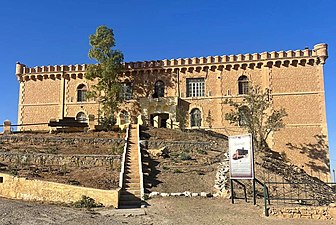Fort Bouscaren
Script error: No such module "Draft topics". Script error: No such module "AfC topic".
| برج بوسكارين | |
 | |
| Designer | Giacomo Molinari |
|---|---|
| Builder | French colonial army |
| Type | Fort |
| Material | gypsum and lime |
| Inauguration date | 1857 |
Fort Bouscaren (in Arabic: برج بوسكارين), also known as Fort Tizegrarine, is a fortification located north-east of Laghouat[1]. It was built in 1857[2] by the French colonial army, with architecture conceived by the Italian architect Giacomo Molinari.
History[edit]
The fort was built on the site of "Bordj-El Gharbi", where there was already a fortress and an observatory before the city of Laghouat was taken by the French army in 1852. The same year, General Du Barail, supported by Marshal Randon, Governor General of occupied Algeria, decided to replace the collapsed defensive towers with two new fortresses[3]: Fort Morand in 1856 and Fort Bouscaren in 1857.
General Henri Pierre Bouscaren had participated in the landing at Sidi Fredj on July 5, 1830, as well as the capture of Laghouat where he was killed by local resistance. The fort was built in 1857 using local limestone, gypsum and lime.
The fort consists of four wings of two floors, surrounded by a courtyard opening to the west, at the place of the water reservoir. The main wing forms the eastern facade of the building, made through an arched and lined corridor, composed of two floors and topped by guard towers in the form of battlements.
The west side is topped by an enclosure opening through embrasures and watcher's holes for observation and surveillance. In the southern part of the fort is the tomb of General Bouscaren, killed in 1852 during the battle for the capture of the city.
This fort housed the military garrison of the French colonial army, before serving as a military hospital. At Algeria's independence, the Algerian People's National Army inherited this building which served as headquarters of the National Directorate of Construction (DNC).
This building has been assigned to the Ministry of Culture since 1994 to accommodate its structures. Since September 30, 2010, it has served as headquarters of the National Office of the Saharan Atlas Cultural Park (ONPCAS).
Galery[edit]
-
Fort Bouscaren in the 1900s.
-
Fort Bouscaren in 2023.
-
The fountain inside the fort.
-
The entrance of the fort.
References[edit]
Some use of "" in your query was not closed by a matching "".
- ↑ Mangin, E. (1895). Notes sur l'histoire de Laghouat (in français). Jourdan. Search this book on

- ↑ Melle Bensadia Zahra (2015). "Architecture chrétienne en Algérie (1830-1962) cas de l'église Saint-Hilarion" (PDF). Mémoire (in français): 28.
- ↑ Jacqueton, Gilbert (1911). Algérie et Tunisie (in français). Hachette. Search this book on

This article "Fort Bouscaren" is from Wikipedia. The list of its authors can be seen in its historical and/or the page Edithistory:Fort Bouscaren. Articles copied from Draft Namespace on Wikipedia could be seen on the Draft Namespace of Wikipedia and not main one.




